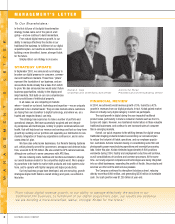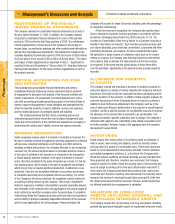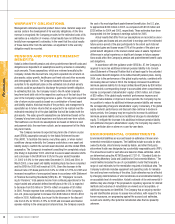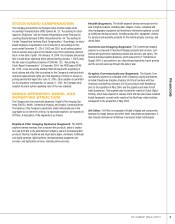Kodak 2004 Annual Report Download - page 8
Download and view the complete annual report
Please find page 8 of the 2004 Kodak annual report below. You can navigate through the pages in the report by either clicking on the pages listed below, or by using the keyword search tool below to find specific information within the annual report.
Financials
6
EASTMAN KODAK COMPANY
n Management’s Discussion and Analysis
of Financial Condition and Results of Operations
RESTATEMENT OF PREVIOUSLY
ISSUED FINANCIAL STATEMENTS
The Company restated its consolidated fi nancial statements as of and for
the year ended December 31, 2003. In addition, the Company restated
its quarterly consolidated fi nancial statements for each of the quarterly
periods in 2003 and for the fi rst three quarters of 2004. The restatement
refl ects adjustments to correct errors in the Company’s accounting for
income taxes, accounting for pensions and other postretirement benefi ts as
well as other miscellaneous adjustments. The restatement resulted in the
Company adjusting its previously reported 2003 net income of $265 million
($.92 per share) to net income of $253 million ($.88 per share). The nature
and impact of these adjustments are described in Note 1: “Signifi cant Ac-
counting Policies and Restatement.” Also see Note 24: “Quarterly Sales and
Earnings Data-Unaudited” for the impact of these adjustments on each of
the quarterly periods.
CRITICAL ACCOUNTING POLICIES
AND ESTIMATES
The accompanying consolidated fi nancial statements and notes to
consolidated fi nancial statements contain information that is pertinent
to management’s discussion and analysis of the fi nancial condition and
results of operations. The preparation of fi nancial statements in confor-
mity with accounting principles generally accepted in the United States of
America requires management to make estimates and assumptions that
affect the reported amounts of assets, liabilities, revenue and expenses,
and the related disclosure of contingent assets and liabilities.
The Company believes that the critical accounting policies and
estimates discussed below involve the most complex management judg-
ments due to the sensitivity of the methods and assumptions necessary in
determining the related asset, liability, revenue and expense amounts.
REVENUE RECOGNITION
Kodak recognizes revenue when it is realized or realizable and earned. For
the sale of multiple-element arrangements whereby equipment is combined
with services, including maintenance and training, and other elements,
including software and products, the Company allocates to, and recognizes
revenue from, the various elements based on verifi able objective evidence
of fair value (if software is not included or is incidental to the transaction)
or Kodak-specifi c objective evidence of fair value if software is included
and is other than incidental to the sales transaction as a whole. For full ser-
vice solutions sales, which consist of the sale of equipment and software
which may or may not require signifi cant production, modifi cation or cus-
tomization, there are two acceptable methods of accounting: percentage
of completion accounting and completed contract accounting. For certain
of the Company’s full service solutions, the completed contract method of
accounting is being followed by the Company. This is due to insuffi cient
historical experience resulting in the inability to provide reasonably depend-
able estimates of the revenues and costs applicable to the various stages of
such contracts as would be necessary under the percentage of completion
methodology. When the Company does have suffi cient historical experience
and the ability to provide reasonably dependable estimates of the revenues
and the costs applicable to the various stages of these contracts, the
Company will account for these full service solutions under the percentage
of completion methodology.
At the time revenue is recognized, the Company also records reduc-
tions to revenue for customer incentive programs in accordance with the
provisions of Emerging Issues Task Force (EITF) Issue No. 01-09, “Ac-
counting for Consideration Given from a Vendor to a Customer (Including a
Reseller of the Vendor’s Products).” Such incentive programs include cash
and volume discounts, price protection, promotional, cooperative and other
advertising allowances, and coupons. For those incentives that require
the estimation of sales volumes or redemption rates, such as for volume
rebates or coupons, the Company uses historical experience and internal
and customer data to estimate the sales incentive at the time revenue
is recognized. In the event that the actual results of these items differ
from the estimates, adjustments to the sales incentive accruals would be
recorded.
ALLOWANCE FOR DOUBTFUL
ACCOUNTS
The Company records and maintains a provision for doubtful accounts for
customers based on a variety of factors including the Company’s historical
experience, the length of time the receivable has been outstanding and the
fi nancial condition of the customer. In addition, Kodak regularly analyzes its
customer accounts and, when it becomes aware of a specifi c customer’s
inability to meet its fi nancial obligations to the Company, such as in the
case of bankruptcy fi lings or deterioration in the customer’s overall fi nancial
condition, records a specifi c provision for uncollectible accounts to increase
the allowance to the amount that is estimated to be uncollectible. If cir-
cumstances related to specifi c customers were to change, the Company’s
estimates with respect to the collectibility of the related receivables could
be further adjusted. However, losses in the aggregate have not exceeded
management’s expectations.
INVENTORIES
Kodak reduces the carrying value of its inventory based on estimates of
what is excess, slow-moving and obsolete, as well as inventory whose
carrying value is in excess of net realizable value. These write-downs are
based on current assessments about future demands, market conditions
and related management initiatives. If, in the future, the Company deter-
mined that market conditions and actual demands are less favorable than
those projected and, therefore, inventory was overvalued, the Company
would be required to further reduce the carrying value of the inventory and
record a charge to earnings at the time such determination was made. If,
in the future, the Company determined that inventory write-downs were
overstated and, therefore, inventory was undervalued, the Company would
recognize the increase to earnings through higher gross profi t at the time
the related undervalued inventory was sold. However, actual results have
not differed materially from management’s estimates.
VALUATION OF LONG-LIVED
ASSETS, INCLUDING GOODWILL AND
PURCHASED INTANGIBLE ASSETS
The Company reviews the carrying value of its long-lived assets, including
goodwill and purchased intangible assets, for impairment whenever events





















